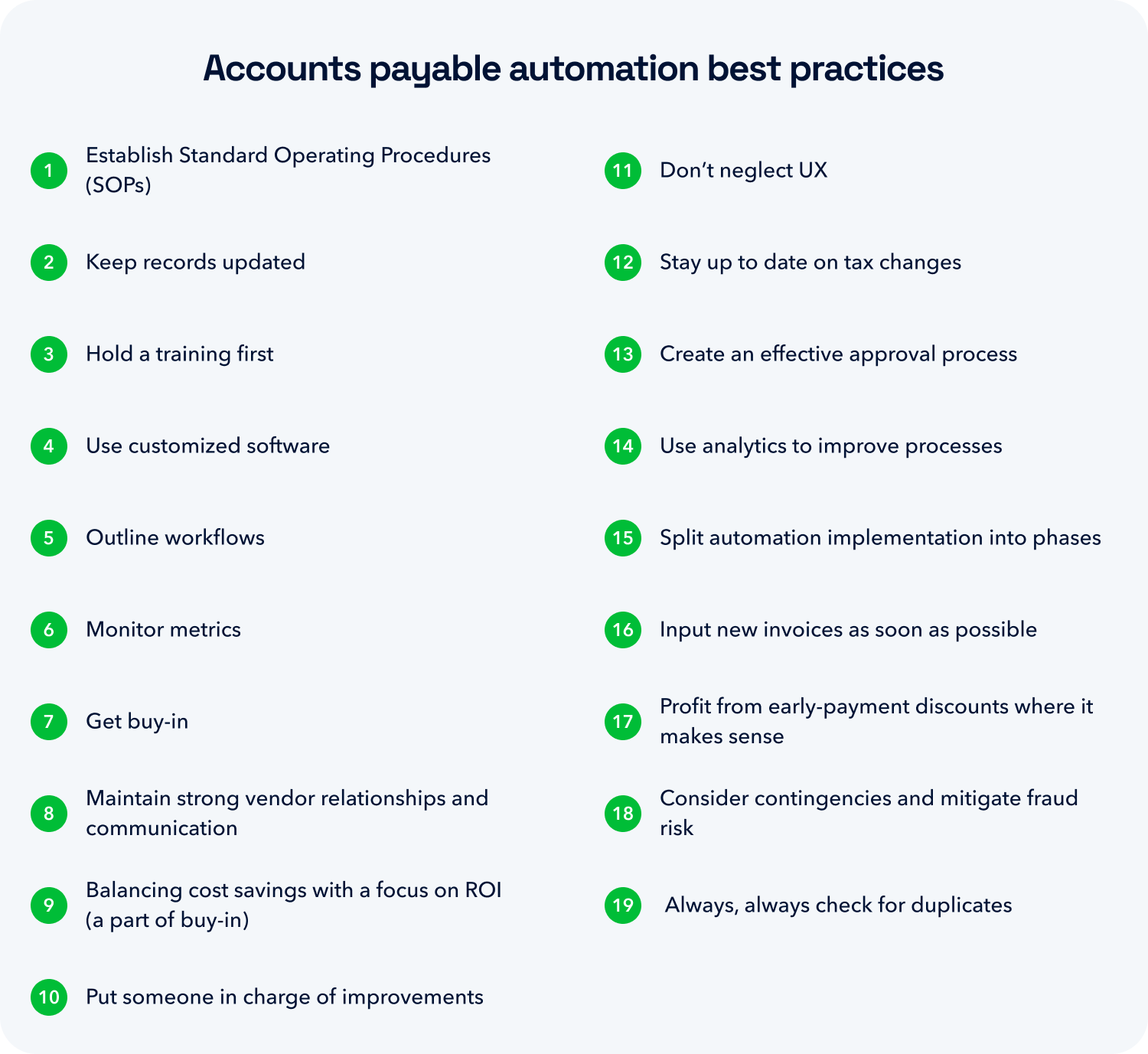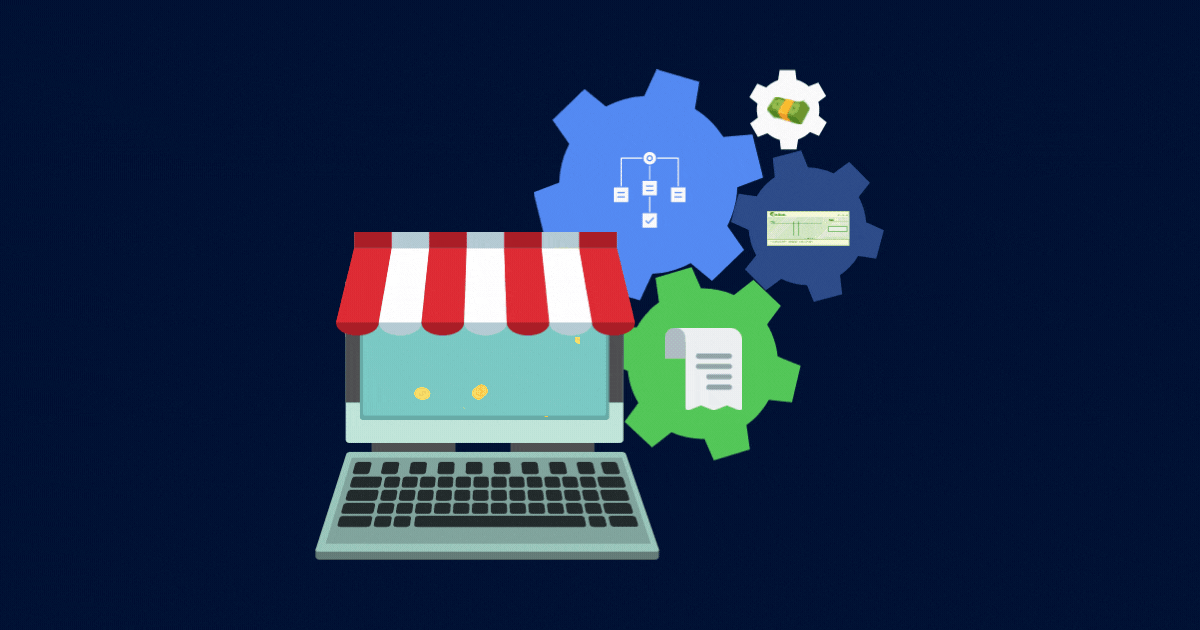
When it comes to accounting processes, accounts payable (AP) automation emerges as a vital tool for enhancing accuracy and efficiency.
What is accounts payable automation?
Essentially, AP automation is a way to minimize manual AP processes and avoid human error from accounts payable operations by digitizing tasks and collecting invoice data electronically.
Through accounts payable software that’s integrated with online payment networks, businesses can virtually connect with all trade partners, giving them a streamlined approach to payments and other finances.
Not only does automation reduce manual data entry, but it also frees up cash flow, ensures compliance, and helps companies track key performance indicators (KPIs) and allocate resources most efficiently.
Below, we dive into the most important AP automation best practices so your company get the most out of automation.
Accounts payable automation best practices
When delving into AP automation, several best practices can help smooth the transition.
1. Establish Standard Operating Procedures (SOPs)
SOPs are foundational. Having them in place will help eliminate guesswork.
By using accounts payable software solutions, businesses can create guardrails for daily work, which will expedite many AP workflows & transactions, from invoice processing to audits to vendor evaluation.
2. Keep records updated
Promptly entering new invoices into the system ensures fast and accurate processing — the most important piece of account payments.
It also protects you against late payments or lost invoices, both of which can cost your company its relationships, time, and money.
Automation helps give the team deeper and more timely insight into their accounts payable processes so potential issues or areas for improvement can be identified. Real-time data can be relied on for a better perspective on the company’s financial position.
3. Hold a training first (as many as it takes)
As you explore an AP software solution, hold training calls with the software provider and make sure your package comes with support for all new, current, and future users.
Involve your employees early to ensure that they're proficient in using the software. This will maximize the benefits of the automation.
4. Use customized software
Consider using a custom solution that speaks the language of your current AP department instead of forcing your team to conform to the software. Any vendor worth their salt will be happy to explain how they integrate with your stack.
Depending on the software, you might be able to tailor it to specific user roles which helps cut down on the confusion of unnecessary information. It also ensures separation of duties so nobody has access to information they shouldn’t — an overall business best practice.
5. Outline workflows
Use a whiteboard to sketch out workflows with your team, or use workflow mapping software to help identify bottlenecks and inefficiencies. Doing so can pave the way for streamlined processes and consistencies. It will also help you recognize exceptions and how they should be handled.
6. Monitor metrics
Track AP metrics for tasks such as invoice processing times, user activities, payment forecasts, approval times, and average cost per invoice. Monitor the status of your invoice program so you can compare the metrics before and after automation.

7. Get buy-in
Change can be a challenge. And new technology can make the transition even more complex.
The key to successful adoption and implementation is for leadership to explicitly support the change.
To make that happen, stakeholders should know how the change to AP automation aligns with business objectives and will have a justifiable return on investment (ROI).
From the top down, everyone should understand the benefits and why the decision to automate was made. Be sure to communicate it to your suppliers, too, since their adoption is also important.
8. Maintain strong vendor relationships and communication
Be sure to communicate the change over to automation with your suppliers since their adoption is also important. Ask for their feedback so you can collaborate in the best possible way while maximizing the software’s potential to streamline time-consuming processes and drive mutual success.
Once your payment processing is in place, you might be able to take advantage of early-payment discounts — early payment helps everyone involved when it’s possible.
9. Balancing cost savings with a focus on ROI (a part of buy-in)
Investing in technology can be balanced by cost reduction over time. However, not every workflow improvement made possible by automation will be quantitative; some may also be qualitative.
10. Put someone in charge of improvements
Appoint an AP Automation Manager — often an accountant or member of the finance team — as a single point person to facilitate smoother project execution, oversee progress, and minimize bottlenecks. Delegating one liaison will help keep messaging clear, feedback centralized, and updates easy to communicate.
11. Don’t neglect UX
Prioritizing the user experience (UX) guarantees a software adoption that your employees or team members will embrace. If a supplier portal is difficult or confusing, fewer people will want to use it.
A pleasant UX means happier employees and more efficient workflows overall. If you see a tool you find confusing or unintuitive, consider another vendor.
12. Stay up to date on tax changes
It’s critical to stay on top of tax laws and regulatory changes to avoid penalties, fees, and legal action that might sully your reputation.
An automated system mitigates these risks by mapping processes to tax laws and regulations and reducing the manual workload of tax tracking and filing. Compliance is key.
13. Create an effective approval process
Just because this is #13 doesn’t make it any less important.
Crafting an effective approval process that's user-friendly and compliant with internal policies and external regulations is essential.
Unlike paper invoices, electronic documents can be routed for review securely and efficiently, and multi-level access and rules for reviewers should be established and enforced.
Managers should have an opportunity to review invoices and purchase orders before payment. This eliminates duplicate payments or unauthorized purchases before the payments are released and makes the audit trail far easier.
14. Use analytics to improve processes
Advanced analytics and reporting capabilities are among the best features of an AP automation solution. Detailed spending data helps AP teams gain greater visibility into when and where money is being spent, allowing them to save costs by identifying potential areas of fraud and inefficiency.
15. Split automation implementation into phases
Gradually implementing automation into your AP process helps your team fully grasp new technology without becoming overwhelmed. Creating implementation phases can be helpful for your team, especially if the software is more complicated.
16. Input new invoices as soon as possible
A good habit to get into is adding invoices to the software/process as soon as it is received. This keeps your process timely and ensures you don't fall behind or get overwhelmed.
17. Profit from early-payment discounts where it makes sense
Organize your payment schedule to take advantage of discounts when you can - and as long as it doesn’t impact a healthy cash flow. To help reach these discounts, implement an automated workflow to speed up your process.
18. Consider contingencies and mitigate fraud
Unprecedented things happen all the time - ensure you have contingency plans. Your staff should know manual processes just in case, which means you should have documentation about what your AP process looks like.
Consider ways your team can mitigate fraud, including system parameters, policies, and checking for fake vendors.
19. Always, always check for duplicates
Regardless of whether your AP process is manual or aided by software, make sure to check for duplicate invoices.
The rising importance of AP automation across industries
Across most industries, accounts payable automation has emerged as a linchpin for organizational efficiency and financial control.
From agriculture to education, government agencies to restaurants, businesses across the spectrum are embracing AP automation to bolster productivity, streamline and better control financial processes, and improve vendor relationships.
How to choose the best automated AP system for your business
When selecting an AP automation tool from the hundreds available, consider...
- Price
- Integration capabilities
- Features
- Customer support
- Alignment with business goals matter
The right tool for you will be able to provide most if not all of these things.
Cost is always a factor, but the cheapest solution may not be the best for you if it comes with additional data storage or access fees, processing fees, or feature restrictions that you might eventually need.
Future-proofing your software ensures adaptability to evolving business needs, guaranteeing long-term viability.
Some tools focus solely on automation, so if you go with such an option, you’ll want to make sure it is capable of integrating with the legacy systems you already have in place, including enterprise resource planning (ERP) systems. Determine if the software integrates with custom development, as well as the level of maintenance required, who’ll do it, and what it will cost.
Security is always a priority. Therefore, you may want to consider a cloud-based solution that can offer more secure data capture and automatic updates.
Embracing these accounts payable best practices will make your workflow more accurate and efficient — and it’ll also position your business for future scale using software.












